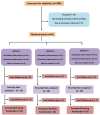Comparative evaluation of postoperative pain and periapical healing after root canal treatment using three different base endodontic sealers - A randomized control clinical trial
- PMID: 35173897
- PMCID: PMC8842288
- DOI: 10.4317/jced.59034
Comparative evaluation of postoperative pain and periapical healing after root canal treatment using three different base endodontic sealers - A randomized control clinical trial
Abstract
Background: The aim of the present study was to evaluate and compare the postoperative pain and periapical healing after root canal treatment using three different base endodontic sealers.
Material and methods: Primary root canal treatment was initiated in 63 patients diagnosed with necrotic pulp and apical periodontitis, cleaning and shaping was completed in two visit and different base endodontic sealers were used for obturation were selected based on the random allocation of the participants to the following groups; Tubli-Seal, AH Plus and BioRoot RCS. Postoperative pain was recorded by using 100 mm visual analog scale at 24 h, 48 h, 72 h and 7 d after obturation. Digital periapical radiographic evaluation was done to assess rate of periapical healing at baseline, 1, 3 and 6 months. Statistical analysis was done using Kruskal Wallis test and one-way ANOVA.
Results: The mean difference in the size of periapical lesions for Tubli-Seal (6.27, 13.41), AH Plus (3.86, 9.80) and BioRoot RCS (4.05, 10.22) at 3 months and 6 months respectively. The mean pain scores at 24 h for Tubli-Seal (17.94 ± 11.35), AH Plus (11.57 ± 11.18), BioRoot RCS (4.73 ± 7.72). At 48 h, Tubli-Seal (5.26 ± 9.04), AH Plus (1.57 ± 3.74) and BioRoot RCS (1.57 ± 3.74) respectively. The mean pain score at 72 h for Tubli-Seal was 2.63 ± 7.33 whereas none of the patients had reported pain in AH Plus and BioRoot RCS group. None of the patients had pain after 7 d of treatment.
Conclusions: BioRoot RCS showed less postoperative pain compared to AH Plus and Tubli-Seal and showed better periapical healing compared to AH Plus and Tubli-Seal at 3 and 6 months intervals respectively. Key words:BioRoot RCS, root canal obturation, root canal sealers, periapical periodontitis, Periapical healing, postoperative pain.
Copyright: © 2022 Medicina Oral S.L.
Conflict of interest statement
Conflicts of interest None declared.
Figures


Similar articles
-
A Comparative Evaluation of Post-operative Pain in Patients Undergoing Root Canal Treatment With Four Different Types of Sealers: A Randomized Controlled Trial.Cureus. 2025 May 25;17(5):e84766. doi: 10.7759/cureus.84766. eCollection 2025 May. Cureus. 2025. PMID: 40557029 Free PMC article.
-
Comparative evaluation of postoperative pain and periapical healing after root canal treatment using three different endodontic sealers: A randomized controlled clinical trial.J Conserv Dent Endod. 2024 Sep;27(9):962-969. doi: 10.4103/JCDE.JCDE_334_24. Epub 2024 Sep 7. J Conserv Dent Endod. 2024. PMID: 39450356 Free PMC article.
-
Antimicrobial Effectiveness of Calcium Silicate Sealers against a Nutrient-Stressed Multispecies Biofilm.J Clin Med. 2020 Aug 24;9(9):2722. doi: 10.3390/jcm9092722. J Clin Med. 2020. PMID: 32846942 Free PMC article.
-
Comparative Evaluation of the Antimicrobial Efficacy of Endodontic Sealers Against Staphylococcus aureus and Streptococcus mutans: An In Vitro Study.Cureus. 2025 Mar 11;17(3):e80435. doi: 10.7759/cureus.80435. eCollection 2025 Mar. Cureus. 2025. PMID: 40225476 Free PMC article.
-
Comparative evaluation of resin-based sealers and bioceramic sealers for postoperative pain after endodontic treatment: A systematic review.Dent Med Probl. 2024 Mar-Apr;61(2):293-300. doi: 10.17219/dmp/155885. Dent Med Probl. 2024. PMID: 38686971
Cited by
-
Evaluation of cytotoxicity and anti-inflammatory action of AH-Plus sealer with and without petasin, pachymic acid, curcumin & shilajit: an invitro-study.Sci Rep. 2025 Jul 8;15(1):24413. doi: 10.1038/s41598-025-08761-1. Sci Rep. 2025. PMID: 40628871 Free PMC article.
-
Postoperative pain after single-visit root canal treatments in necrotic teeth comparing instruments' kinematics and apical instrumentation limits - a prospective randomized multicenter clinical trial.BMC Oral Health. 2024 Apr 20;24(1):481. doi: 10.1186/s12903-024-04225-6. BMC Oral Health. 2024. PMID: 38643087 Free PMC article. Clinical Trial.
-
Periapical Healing following Root Canal Treatment Using Different Endodontic Sealers: A Systematic Review.Biomed Res Int. 2022 Jul 8;2022:3569281. doi: 10.1155/2022/3569281. eCollection 2022. Biomed Res Int. 2022. PMID: 35845966 Free PMC article.
-
A comprehensive in vitro comparison of the biological and physicochemical properties of bioactive root canal sealers.Clin Oral Investig. 2022 Oct;26(10):6209-6222. doi: 10.1007/s00784-022-04570-2. Epub 2022 Jun 3. Clin Oral Investig. 2022. PMID: 35660956 Free PMC article.
-
The status of clinical trials regarding root canal sealers.Restor Dent Endod. 2024 Jan 15;49(1):e5. doi: 10.5395/rde.2024.49.e5. eCollection 2024 Feb. Restor Dent Endod. 2024. PMID: 38449500 Free PMC article.
References
-
- Zehnder M. Root Canal Irrigants. J Endod. 2006;32:389–98. - PubMed
-
- Peters OA, Peters CI. Cleaning and Shaping of the Root Canal System. J Comp Pathol. 2012;146:283–7. - PubMed
-
- Dalopoulou A, Economides N, Evangelidis V. Extrusion of Root Canal Sealer in Periapical Tissues - Report of Two Cases with Different Treatment Management and Literature Review. Balkan Journal of Dental Medicine; 2017. pp. 12–8.
LinkOut - more resources
Full Text Sources
Medical
